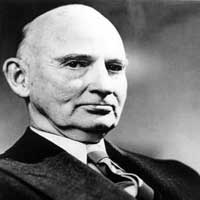Carl Ruggles
 Writing only 84 minutes of music in the entirety of his career, Carl Ruggles’ eight published works nonetheless attest to his complete dedication to atonality and ultra-modernism. Ruggle’s prickly personality was paired with a meticulously deliberate compositional process – Michael Tilson Thomas recalled visiting the composer and hearing him play “every sonority, every chord . . . once, twice, 10, 20, 50, perhaps hundreds of times, as loud as he could, because as he said to me, ‘I thought that if I could still stand the sound . . . after a hundred times or so, it would sound pretty good a couple of hundred years from now!”
Writing only 84 minutes of music in the entirety of his career, Carl Ruggles’ eight published works nonetheless attest to his complete dedication to atonality and ultra-modernism. Ruggle’s prickly personality was paired with a meticulously deliberate compositional process – Michael Tilson Thomas recalled visiting the composer and hearing him play “every sonority, every chord . . . once, twice, 10, 20, 50, perhaps hundreds of times, as loud as he could, because as he said to me, ‘I thought that if I could still stand the sound . . . after a hundred times or so, it would sound pretty good a couple of hundred years from now!”
Carl Ruggles (1876-1971) was born in Massachusetts and started with violin lessons at the age of four. As a teen, he worked in theater orchestras and as an adult, he patched together a career of teaching, performing and conducting. In 1907, he moved to Winona Minnesota, where he founded a YMCA orchestra and began to write an opera, The Sunken Bell, based on Gerhart Hauptmann’s poem. After Ruggles moved to New York in 1917, the unfinished work was accepted by the Metropolitan Opera. However, apparently dissatisfied with the translation he was using, Ruggles destroyed it and only notes remain. His first published composition wouldn’t be until 1919 with Toys, written for his son’s fourth birthday.
In New York, Ruggles continued to give lessons and conducted at the Rand School of Social Science. He met Varèse and Henry Cowell, who both worked to promote his music (Cowell would end up publishing three of his works). Together with Varèse, Ruggles founded founded the International Composers’ Guild, with the aim to present challenging music to audiences without having to capitulate to commercial interests or demands. Ruggles would continue to espouse the necessity of maintaining musical purity in the face of commodification and commercial forces, which unfortunately led him to make several intolerant and racist remarks – one instance of which led Lou Harrison to cut off all ties with his former friend.
Ruggles’ most famous work, the Sun-Treader, based on a Browning poem, was published in 1931.
In 1924, Ruggles left New York for Arlington, Vermont where devoted his live to revising, composing and painting. He left briefly to teach composition at the University of Miami from 1938-43. His last completed work was Exaltation in 1958, in memory of his wife. He died in 1971.
